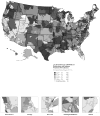Amputation Rates for Patients with Diabetes and Peripheral Arterial Disease: The Effects of Race and Region
- PMID: 26549811
- PMCID: PMC4851557
- DOI: 10.1016/j.avsg.2015.07.040
Amputation Rates for Patients with Diabetes and Peripheral Arterial Disease: The Effects of Race and Region
Abstract
Background: It remains unknown whether care of high-risk vascular patients with both diabetes and peripheral arterial disease (PAD) is improving. We examined national trends in care of patients with both PAD and diabetes.
Methods: A cohort of patients diagnosed with PAD and diabetes between 2007 and 2011 undergoing open or endovascular diagnostic or revascularization procedures was analyzed using Medicare claims data. Main outcome measure was amputation-free survival measured from time of initial revascularization procedure to 24 months, stratified by race and hospital referral region (HRR).
Results: From 2007 to 2011, 2.3 per 1,000 patients underwent a major amputation with the higher rate among black patients (5.5 per 1,000 vs. 1.9 per 1,000; P < 0.001) compared with nonblack. The rate varied widely by HRR (1.2 per 1,000-6.2 per 1,000), with higher variation in amputation rates in black patients (2.1-16.1 per 1,000). Overall, amputation-free survival was approximately 74.6% at 2 years, 68.4% among black patients, and 75.4% among nonblack patients, with the disparity between the 2 groups increasing over time.
Conclusions: Prevalence of concurrent PAD and diabetes is increasing, but amputation rates and amputation-free survival vary significantly by both race and HRR. Prevention and care coordination effort should aim to limit racial disparities in the treatment and outcomes of these high-risk patients.
Published by Elsevier Inc.
Figures



References
-
- Gregg EW, Li YF, Wang J, et al. Changes in Diabetes-Related Complications in the United States, 1990–2010. New England Journal of Medicine. 2014;370:1514–23. - PubMed
-
- Marso SP, Hiatt WR. Peripheral arterial disease in patients with diabetes. Journal of the American College of Cardiology. 2006;47:921–9. - PubMed
-
- Brownrigg JR, Apelqvist J, Bakker K, Schaper NC, Hinchliffe RJ. Evidence-based management of PAD & the diabetic foot. Eur J Vasc Endovasc Surg. 2013;45:673–81. - PubMed
-
- Kono Y, Muder RR. Identifying the incidence of and risk factors for reamputation among patients who underwent foot amputation. Ann Vasc Surg. 2012;26:1120–6. - PubMed
-
- Mueller T, Hinterreiter F, Luft C, Poelz W, Haltmayer M, Dieplinger B. Mortality rates and mortality predictors in patients with symptomatic peripheral artery disease stratified according to age and diabetes. J Vasc Surg. 2014;59:1291–9. - PubMed
Publication types
MeSH terms
Grants and funding
LinkOut - more resources
Full Text Sources
Other Literature Sources
Medical

